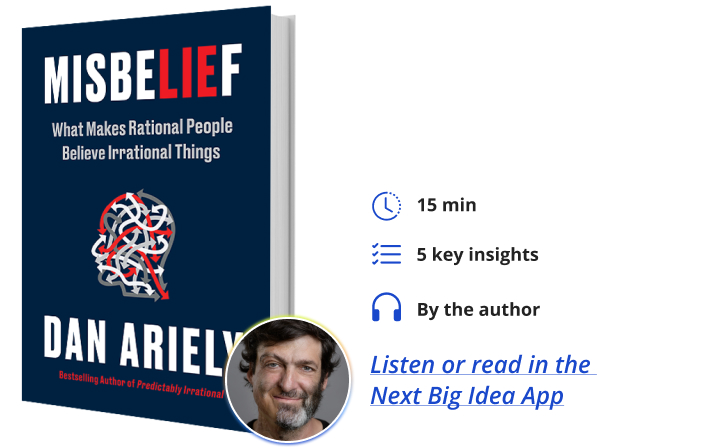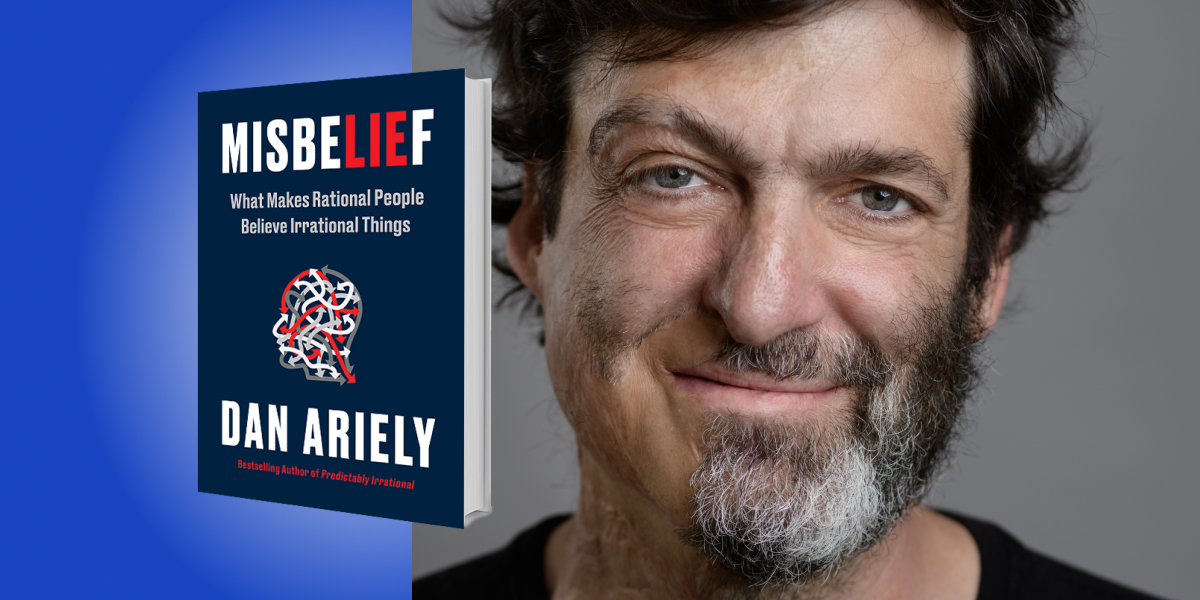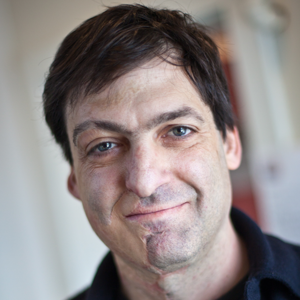Dan Ariely is a bestselling author and the James B. Duke Professor of Psychology and Behavioral Economics at Duke University. He is the founder of the Center for Advanced Hindsight. His work has been featured in the New York Times, the Wall Street Journal, the Washington Post, and the Boston Globe.
Below, Dan shares five key insights from his new book, Misbelief: What Makes Rational People Believe Irrational Things. Listen to the audio version—read by Dan himself—in the Next Big Idea App.

1. The Funnel of Misbelief can explain our society’s loss of trust.
It all started in July 2020, when I got an email from somebody I once knew. She asked me, “Dan, what happened to you? How have you changed?” I didn’t think I changed that much, so I asked her, “How did I change?” She responded with a list of links, one of which had a video of me laying injured in my hospital bed, which is true.
It then described how my injury got me to hate healthy people, how that got me to join Bill Gates and the Illuminati in creating the COVID pandemic. It also caused me to attempt to try and kill as many healthy people as possible using the virus and the vaccines, to control people, and so on. That day started a journey that had multiple stages. In the first stage, I tried to defend myself. During the second stage I understood that I was going to fail. Finally came the long stage of roughly two years of trying to understand the psychology of misbelief.
Fundamental changes in our beliefs are not created for nothing. They’re a reaction to something. But what is this thing and what is this process? Like me, I’m sure you know people who, during the last few years, have changed your beliefs in some fundamental ways. In fact, perhaps the change has been so fundamental that it’s very hard for you to look and see the person that you saw before.
If you think about it, when we see somebody else who likes the color green or the color orange or whatever, we still see them as human being. We don’t think something is wrong with them. But when somebody has such fundamentally different views than ours, when they don’t see the world that we do, when they see dangers in places we don’t, conspiracies where we don’t, no trust where we think trust should be placed, it makes it hard for us to look at them and think that we are of the same species.
But we are of the same species, and they just went through the process of a fundamental change in beliefs. It can be a very interesting, important, and frightening process. Why frightening? Because as a society, the more people that go down the funnel of misbelief, the less trust we have, the less cohesion we have, and the less likely we are able to deal with difficult, complex challenges that are going to come in our path in the future. What makes up this path called the Funnel of Misbelief? There are basically four big psychological elements at play.
2. Stress makes us feel a deep need for understanding and control.
The first element in the Funnel of Disbelief is the emotional component of stress. Now, it’s not just any stress. It’s not, for example, busy-at-work kind of stress. It’s a stress in which we don’t understand how the world is operating. We don’t understand what is going on around us. When we don’t understand what is going on around us, there’s a deep psychological need to come up with a story that explains things. For example, there is an experiment where people are shown a bunch of white and black dots, also known as white noise. People who are stressed while looking at white noise are more likely to see patterns within it.
“When we don’t understand what is going on around us, there’s a deep psychological need to come up with a story that explains things.”
We need to understand that when people are in a stressful situation, they have a deep need to find an answer. But what kind of an answer? You could ask, why don’t they start believing in God, for example. It turns out, when you’re looking for an answer that explains why something bad happens, it’s much easier to find a villain rather than a good force. Not only that, but stressed people want to feel in control.
They want to feel that they understand something that other people don’t. They tell themselves a rather complex story with lots of nuance, that contains good and evil, so they cannot be blamed.
3. Cognitively, we fall victim to the Funnel of Misbelief through search bias and motivated reasoning.
In the cognitive world, we have two general forces. One of those forces is how we search for information. We look at information that is going to confirm our hypothesis. When we look online, we don’t look at search terms that would disconfirm our hypothesis. We look at things that would show us that we are correct. The second force is called motivated reasoning. That’s the part where we are bending reality. If you think about search bias, there’s a whole world of information around us, but we only look at a part of it. Which parts? The part that we think will confirm our hypothesis.
The cognitive force of motivated reasoning means that we not only just look in a biased way, but we can actually bend reality. We find the answers that we want to find.
The cognitive elements, of course, have many more parts to them. There is escalation, when people start saying things they don’t believe just to show loyalty to the group and over time they start believing them. There is also cognitive dissonance, when people end up really committed to their cause, even if they were not committed in the beginning, just because they have said, posted, and commented so much already.
4. Personality can determine our likelihood of going down the Funnel of Misbelief.
Personality is important because not everybody is as likely to go down the Funnel of Misbelief. We all have some potential of going down this funnel. We all have a potential of losing trust in all kinds of institutions, but some people are more likely than others to do so. To illustrate this personality part, we will talk about alien abductees. There are some people who believe that they were abducted by aliens. How does that happen? How do people come to believe that?
During REM sleep, our brain not only submits instructions to the body—fly, run, pull your sword, save the princess, things like that—but the brain also paralyzes the body to some degree. The brain submits these instructions, but simultaneously makes sure that they don’t get carried out. That’s why when we are in REM sleep, we don’t actually move and follow those instructions. This is called sleep paralysis. It turns out that a small part of the population, some people estimate about 8 percent of the population, wake up while still in sleep paralysis.
“People who have this kind of faulty memory, who remember things that belong in principle but were not actually in the set, are more likely to develop the belief that they were abducted by aliens.”
If you ask around, it’s likely that some of your friends and family will tell you of a time that it has happened to them. After waking up feeling paralyzed, it takes a few seconds, sometimes 30 to 60 seconds, for this paralysis to go away. From these eight or so percent of people who have sleep paralysis, not everybody starts believing that they were abducted by aliens. So, what happened with those that do? Why do some people believe that and some people don’t?
There are some interesting personality traits that make it more likely. For example, imagine you are given a set of words: orange, apple, banana. We wait a few minutes, and then I ask you, “Hey, did the word apricot appear in that list?” If you wrongly say yes, you have a particular kind of faulty memory. This faulty memory can cause you to remember things that were not there. You think you remember them simply because they fit the general structure.
People who have this kind of faulty memory, who remember things that belong in principle but were not actually in the set, are more likely to develop the belief that they were abducted by aliens. You can imagine how it works; you wake up, you have sleep paralysis, you add details, you add to the picture. Later on, you start to remember even more details and eventually, you believe in the only possible explanation for everything you experienced: that you have been abducted by aliens.
Of course, this is not the end of the story, and this kind of faulty memory is not the only personality trait that increases your distrust in the world. People who believe more in their intuitions, people who believe in magical ideation, reverse causality, and have a tendency towards narcissism are also more likely to fall into misbelief.
5. Social cohesion has a powerful influence on our ability to trust.
Usually when we think about social influences, we think about social media. Of course, social media is part of the story, but it’s not the whole story. The social component is actually incredibly important, and it reflects a lot of what social psychologists have shown over the years.
There are a couple of examples regarding this. The first example is called ostracism. The person who started this research, Kip Williams, describes the following story. He walks with his dog in the park. As he walks by, two people are playing frisbee. By mistake, the frisbee falls next to his legs. He picks it up and he throws it to them, and the three of them start throwing it to each other for a while.
He did not know these people. He didn’t come to play with them, but he became one of the people playing with them. They play for a few minutes, as three, and then the other two people stop throwing the Frisbee to him. He stands there waiting for a few seconds, and he feels terrible. Why do they suddenly not want to play with him? Of course, they did not know him. They didn’t come to play with him, but he feels rejected and ostracized.
“Trust is all around us. Because of that, we don’t often notice how big and important its effect is on our behavior.”
Since then, he’s been doing lots of experiments showing the effect of ostracism and how it influences people. Ostracism negatively affects our well-being, hopefulness for the future, collaboration, and more.
We have a deep need to belong. Imagine we were at dinner and I make the suggestion that maybe the Earth is flat and you make fun of me. Maybe you consider your comment as a funny little quip, but my experience might be much different. Maybe I feel ostracized or rejected from the group. If this happened again, maybe I start to look for a group of people who see the world in the same way that I do. Social cohesion can influence people to find others who are more like them.
The big picture in all of this, of course, is not just the Funnel of Misbelief, it’s not just about the change we make, it’s the implications from it. The implications from it are quite dire for society. Our society relies a lot on trust. It’s like fish in water. Fish don’t notice the water, so they say, because it’s all around them. Trust is the same. Trust is all around us. Because of that, we don’t often notice how big and important its effect is on our behavior.
But the reality is that people who go down the Funnel of Misbelief lose trust and they pay a price—and we, as a society, pay a price.
To listen to the audio version read by author Dan Ariely, download the Next Big Idea App today:































